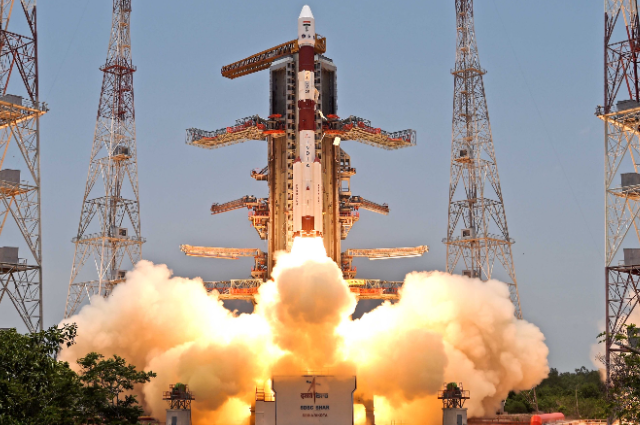
The Aditya-L1 mission, India's first space-based observatory dedicated to studying the Sun has executed its second Earth-bound manoeuvre successfully. It marks a significant milestone in India's space exploration endeavors, as it represents the country's significant space-based observatory exclusively focused on studying the Sun. When the mission achieved a crucial accomplishment by executing its second Earth-bound maneuver flawlessly it highlighted India's commitment to advancing solar research and enhancing our understanding of the Sun's dynamics.
The second Earth-bound manoeuvre conducted on September 5, 2023, at the ISRO Telemetry, Tracking, and Command Network (ISTRAC) in Bengaluru, marks another step forward in the mission's journey to investigate the Sun's mysteries. The Aditya-L1 spacecraft, monitored closely by ground stations at Mauritius, Bengaluru, and Port Blair, completed this crucial manoeuvre in the early hours of September 5. The result was the achievement of a new orbit with dimensions of 282 kilometers by 40,225 kilometers. This accomplishment comes shortly after the successful execution of the first Earth-bound manoeuvre on September 3, during which the spacecraft was inserted into an elliptical orbit of 235 kilometers by 19,500 kilometers around Earth.
Aditya L1 got its name from the Hindu god, Surya or Aditya, who represents the Sun. The "L1" in its name stands for Lagrange Point 1, which is the exact spot between the Sun and Earth where the spacecraft is supposed to go. This idea for the mission was first thought up in January 2008 by the Advisory Committee for Space Sciences (ADCOS). Now with the initiation of ISRO, Aditya-L1's primary objective is to study the Sun from a unique vantage point - a halo orbit around the first Sun-Earth Lagrangian point (L1), located approximately 1.5 million kilometers from Earth. Placing a satellite in this strategic location offers the distinct advantage of uninterrupted solar observation without any occultation or eclipses. This continuous monitoring will enable scientists to gain real-time insights into solar activities and their impact on space weather.
The mission carries seven scientific payloads developed indigenously by ISRO and national research laboratories, including the Indian Institute of Astrophysics (IIA) in Bengaluru and the Inter-University Centre for Astronomy and Astrophysics (IUCAA) in Pune. These payloads are designed to observe various layers of the Sun using electromagnetic, particle, and magnetic field detectors. Efficient communication infrastructure is essential to receive data from the mission's payloads, and here, the European Space Agency (ESA) plays a crucial role. ESA's deep space communication services ensure the reception of scientific data and provide information about the spacecraft's location and status. This collaboration between ISRO and ESA is set to continue throughout the Aditya-L1 mission's two-year routine operations.
The Aditya-L1 mission was launched successfully aboard ISRO's Polar Satellite Launch Vehicle (PSLV-C57) on September 2, 2023, from the Second Launch Pad of the Satish Dhawan Space Centre (SDSC) in Sriharikota.
Three more manoeuvres are scheduled, with the next one slated for September 10, 2023, at approximately 02:30 AM IST. After the final manoeuvre on September 18, the spacecraft will undergo a Trans-Lagrangian1 insertion manoeuvre, marking the beginning of its 110-day trajectory toward the L1 Lagrange point. Upon reaching the L1 point, Aditya-L1 will be bound to an orbit around L1, a gravitationally stable location between Earth and the Sun. Throughout its mission life, the Aditya-L1 spacecraft will orbit L1 in an irregularly shaped orbit, roughly perpendicular to the line connecting Earth and the Sun.
The Aditya-L1 mission aims to enhance our understanding of the Sun's outer layers, chromosphere, and corona, shedding light on solar processes and phenomena that remain poorly understood. The insights gained from this mission could benefit the study of distant stars and have implications for life on Earth and its support systems, which are intricately linked to the Sun. This knowledge is of utmost importance, as it will contribute to improved space weather predictions, understanding of solar winds, solar flares, and their effects on communication and navigation systems.
After the Chandrayaan-3 mission's success, the Aditya-L1 mission also strengthened India's position as a space-exploring country determined to advance scientific research beyond Earth's limits. The continued advancement of these missions illustrates India's relentless commitment to pushing the boundaries of scientific exploration in space. It is a testament to India's influence in space technology and its dedication to unraveling the secrets of the universe. With each successful mission, India not only adds to its space achievements but also reinforces its status as a prominent space-faring nation, inspiring both its own citizens and the global community to reach for the stars in the pursuit of knowledge and discovery.
. . .
References:
